This article is part of the 31 Days of Pinterest Hacks series. Find the main page for this series here.
A part of school life includes cutting and pasting. From art activities to cutting up fractions, being able to cut and paste is a skill required to complete them. However, a physically disabled child may never get to découpage because they need support holding a pair of scissors and would rather taste glue than stick two things together.
You can find scissors and glue skills practice on Pinterest.
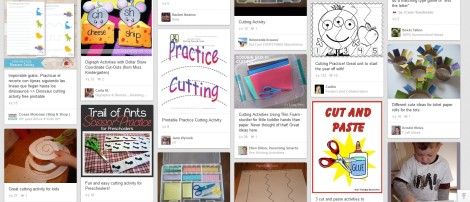
A child must be able to cut and paste to complete many of the craft ideas on Pinterest.
Why cutting and pasting may be a challenge for neurodivergent and disabled children
- Children requiring fine motor support may struggle to coordinate the cutting sequence.
- Children who still mouth objects may want to lick the glue.
- Squeezing a glue bottle may be challenging for children requiring fine motor support.
- Children experiencing visual-motor difficulties may be challenged by cutting on a line.
Suggestions for adaptations/modifications for cutting and pasting
- Model. Before expecting a child to engage in activities that involve using scissors or glue, be sure to have the child observe as you use the materials. Talk through it: “Look. I’m cutting the paper. Cut. Cut. Cut. Cut. All done!” “I’m sticking the paper to the scrapbook. Dot, dot. Tap, tap, tap. All done!”
- Offer the proper supplies. Finding the right tools for a neurodivergent or disabled child might take a little effort (and a little money). Look through catalogues that market to disabled learners. Keep an open mind. Alternatively, ask the child’s occupational therapist for ideas.
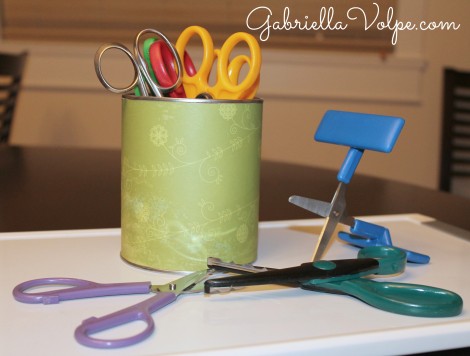
Here are a variety of scissors. Try everything from the standard to the adapted kinds to find the right match for the child. Experiment with zig-zagged edges if the child has mastered holding a standard scissor.
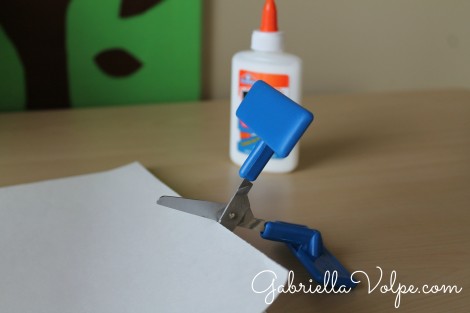
This is an adapted scissor I use with my son. It rests upright on the table, and he must press the top pallet down. We do this hand-over-hand (with consent) at the moment, but this is a pair of scissors he’ll likely be able to use independently one day.
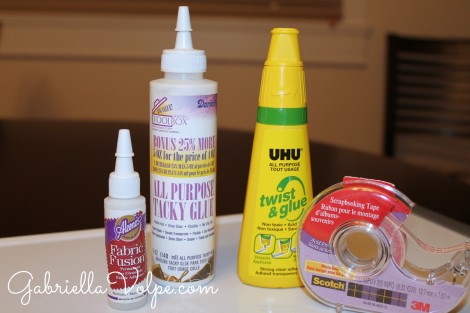
These are a variety of glues and glue bottles. The smallest is very easy to manipulate, even if it’s fabric glue. The all-purpose bottle is softer than the school glue and can be squeezed easily. The twist glue is flatter, making it relatively easy to hold as well. If the child insists on mouthing glue, consider double-sided tape. An adult might need to tear and remove the strip on the tape pieces, but it offers a sticking option that makes pasting a success for some children.
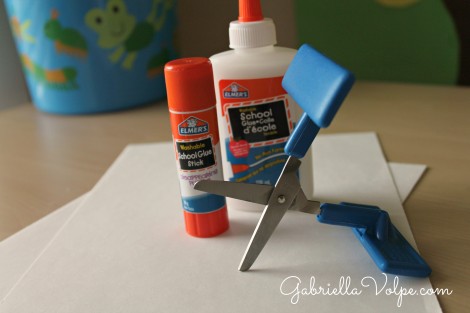
Pictured behind the scissors are traditional school (white glue) and a glue stick. Glue sticks come in a variety of sizes. You might want to start with the widest held in a fist first.
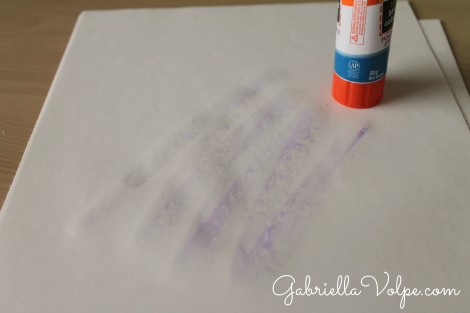
When purchasing stick glue, consider buying the colored kind. The child can see what’s going on the paper and get a different sensory experience. My son loves this glue stick because it glides and marks at the same time. It eventually disappears, so be sure to stick quickly!
If you worry that the child will mouth liquid glue, make some homemade glue instead:
- 1/2 c flour
- 1 ½ c water
- 1/3 c sugar
- 1 tsp vinegar
Heat through until thickened. Let cool before use.
- Work through it hand-over-hand (with consent). After several days of observations and hearing the verbal routine, guide the child through cutting and gluing. Below are some specific tips for each skill.
Cutting
- Work through a simple cutting activity. Begin by cutting the paper in one spot and celebrating! Then, in two spots. Yah! Work up to cutting straight across the page, zig-zags, curves, and simple shapes.
- Use verbal routines: “Cut, cut, cut, stop!” (for straight-line cutting) or “Cut, cut, cut, turn!” (for cutting around a shape) or “Zig, zag. Zig, zag” (for… you got it—zig, zag lines).
Pasting
- When working with liquid glue, put some glue on a paper plate and use a craft stick to scoop it up. I would avoid using a spoon, especially with a child who mouths things. They may confuse this gloop on a spoon with food.
- Don’t avoid squeeze bottles altogether. The bottles on the market are child-friendly in design as they are flatter than, say, a condiments bottle. Work your way up to teaching the child the hand skill of squeezing. Having glue in a bottle will make it less likely for the child to want to stick their hands in it and then lick them! (Although, some kids are quick! Always be vigilant!)
- Work on making dots with glue, lines, zig-zags, and squiggles. The child will love it! My son loves the word “squiggle” and always asks for MORE.
- Use verbal routines: “Dot, dot, dot, tap, tap” (with squeeze bottle) or “Scoop, tap, tap” (with craft stick) or “Whoosh, whoosh, tap, tap” (with a glue stick). We use “tap, tap” for actually sticking the paper onto another paper or object.
What tips and tricks can you share regarding cutting and pasting?
Are you looking for additional support? I offer personalized consultations offering ideas such as these!

Excellent post once again!
For a child who is not too aversive to touching playdough, cutting playdough with scissors can strengthen the hands and give sensory feedback a piece of paper or construction paper can’t.
I found for my son that cutting through a thicker piece of paper was easier, as a thicker piece of paper is less wobbly.
Probably the cut, cut, STOP routine would have helped my child stop cutting on command. As my son will continue cutting straight through, his occupational therapist used sticky tack to indicate when it was time to stop cutting.
Only disadvantage: my little fellow learned in no time that he could cut around the sticky tack… At this point, we created a whole line of sticky tack for him to really get the idea to not cut through the whole length of the sheet.
I am so glad you mentioned the thickness of the paper. That’s a great point when first learning to cut, and hold the sheet at the same time. I can see how the “crunch” sound of a thicker paper (like cardstock) provides sensory feedback as well.
I love that your son learned to cut around the sticky tack! And, that’s such a neat trick, by the way – using it as a stopping point. Brilliant!